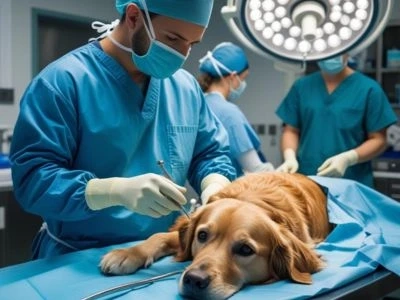When it comes to canine health, one of the most common orthopedic issues pet owners face is a torn ACL. ACL surgery for dogs has become a widely recommended treatment to restore mobility and reduce pain. Whether you're a concerned dog parent or a pet care professional, understanding the basics, benefits, procedures, and recovery related to ACL surgery for dogs is essential.
What is ACL in Dogs?
The ACL (Anterior Cruciate Ligament) in dogs, technically known as the cranial cruciate ligament (CCL), plays a similar role to the ACL in humans. It stabilizes the knee joint and prevents the tibia from sliding forward in relation to the femur. When this ligament is injured or torn, it causes pain, inflammation, and lameness in the affected limb.
ACL injuries can occur due to trauma, obesity, genetic predisposition, or wear and tear over time. Certain breeds like Labrador Retrievers, Rottweilers, and Boxers are more susceptible to CCL injuries.
Signs Your Dog Might Need ACL Surgery
Recognizing the symptoms early can make a big difference in your dog’s recovery. Common signs your dog might need ACL surgery include:
- Sudden limping or holding up a hind leg
- Difficulty getting up or sitting down
- Swelling around the knee
- Reluctance to run, jump, or climb stairs
- Stiffness after rest
If you notice any of these signs, it's important to consult your veterinarian for a diagnosis. ACL surgery for dogs may be recommended after a thorough physical exam and radiographs (X-rays).
Types of ACL Surgery for Dogs
There are several surgical options available based on your dog’s size, age, activity level, and overall health. Below are the most common procedures:
1. Tibial Plateau Leveling Osteotomy (TPLO)
TPLO is one of the most popular and effective methods of ACL surgery for dogs. It involves restructuring the knee joint to eliminate the need for the ACL altogether. This procedure is typically recommended for medium to large breed dogs.
2. Tibial Tuberosity Advancement (TTA)
TTA is another cutting-edge procedure that changes the dynamics of the knee joint, preventing the tibia from shifting. It’s less invasive than TPLO and is suitable for active dogs.
3. Lateral Suture Technique (Extracapsular Repair)
This technique uses a synthetic ligament to mimic the function of the torn ACL. It's commonly used for smaller dogs (under 50 lbs) and involves less surgical complexity.
Each of these methods has its own pros and cons. Your vet or orthopedic surgeon will suggest the best option for your dog’s condition.
Benefits of ACL Surgery for Dogs
- Pain Relief: ACL surgery for dogs provides immediate pain relief by stabilizing the joint.
- Improved Mobility: Post-surgery, most dogs regain their ability to walk, run, and play.
- Reduced Arthritis Risk: Early intervention can prevent the development of osteoarthritis.
- Long-Term Health: Surgical treatment offers a long-term solution and better quality of life.
When compared to conservative treatment (like rest and medications), ACL surgery for dogs has a significantly higher success rate, especially in active and large breed dogs.
What to Expect Before the Surgery
Before your dog undergoes ACL surgery, your vet will conduct:
- A physical examination
- Orthopedic tests
- X-rays or MRIs to evaluate the damage
- Blood work to ensure your dog is healthy for anesthesia
You may be referred to a board-certified veterinary surgeon who specializes in ACL surgery for dogs. A pre-surgical consultation helps in choosing the best surgical method and preparing a tailored recovery plan.
Post-Surgical Care and Recovery
Recovery after ACL surgery for dogs is crucial for optimal healing. Here are some key aspects of post-operative care:
1. Restricted Activity
Your dog will need strict crate rest or confinement for at least 6 to 8 weeks. Avoid any running, jumping, or stairs.
2. Pain Management
Anti-inflammatory drugs and painkillers are prescribed to ensure your dog remains comfortable.
3. Physical Therapy
Rehabilitation exercises such as passive range of motion, underwater treadmill therapy, and massage help speed up recovery.
4. Follow-up Visits
Routine checkups and possibly X-rays will be scheduled to monitor healing and remove sutures.
Full recovery from ACL surgery for dogs usually takes 3 to 6 months, depending on the surgical method and your dog’s health.
Risks and Complications
While ACL surgery for dogs has a high success rate, potential risks include:
- Infection
- Implant failure
- Meniscal injuries
- Lameness in the opposite leg (common if the dog compensates for too long)
Choosing an experienced veterinary surgeon and following post-operative care guidelines reduces these risks significantly.
Cost of ACL Surgery for Dogs
The cost varies depending on the procedure and your location. On average:
- TPLO: $3,000 to $5,000
- TTA: $2,500 to $4,000
- Lateral Suture: $1,200 to $2,500
Though it's a financial commitment, investing in ACL surgery for dogs often prevents future complications and expensive treatments.
Natural Alternatives and Conservative Treatment
In cases where surgery isn't feasible due to age or health conditions, conservative treatment options may include:
- Weight management
- Joint supplements (like glucosamine and chondroitin)
- Anti-inflammatory medications
- Laser therapy
- Orthopedic braces
These methods can offer temporary relief but may not restore full function. Always consult your vet before choosing non-surgical options for ACL injuries.
Conclusion
ACL surgery for dogs is a transformative procedure that can restore your pet’s quality of life. It not only alleviates pain but also enables your dog to return to their playful, active self. With various surgical options, advanced veterinary techniques, and well-structured recovery programs, dogs today have an excellent chance at full rehabilitation.
If you suspect an ACL injury in your dog, don't wait. Prompt diagnosis and treatment — especially ACL surgery for dogs — can lead to a healthier, more comfortable future for your furry companion.



